11 Best Herbal Teas For Gerd
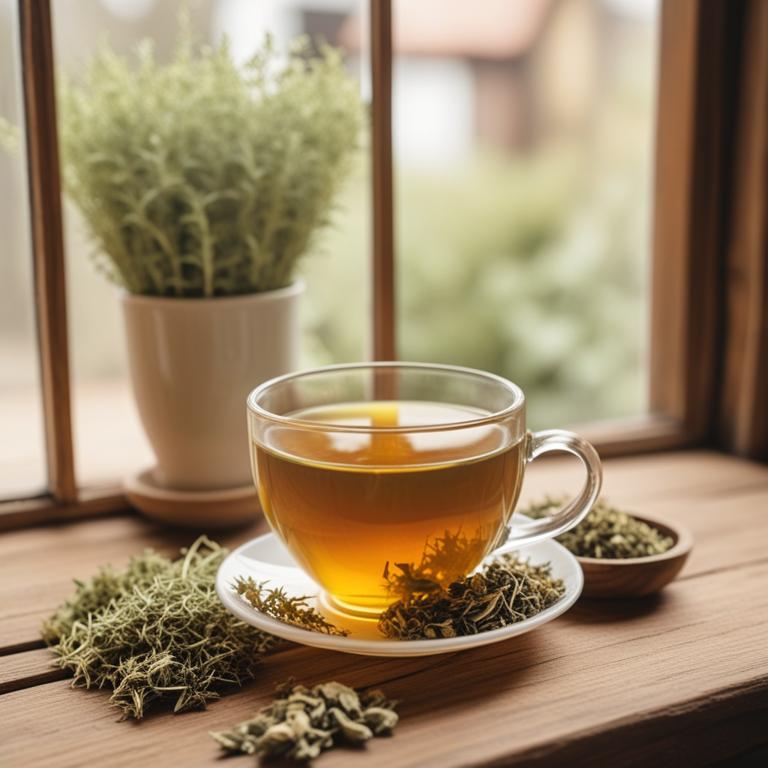
Herbal teas for Gerd are a natural remedy that involves drinking tea made from various herbs to alleviate the symptoms of gastroesophageal reflux disease (GERD).
This ailment occurs when stomach acid flows back up into the esophagus, causing discomfort and pain.
Herbal teas can treat GERD by soothing the digestive system, reducing inflammation, and promoting relaxation, which in turn helps to calm the stomach and prevent acid reflux.
Examples of herbal teas that can help treat GERD include peppermint tea, which eases digestion and reduces nausea, chamomile tea, which calms the stomach and promotes relaxation, licorice root tea, which protects the mucous membranes and reduces inflammation, ginger tea, which soothes the digestive system and reduces nausea, fennel tea, which eases digestion and reduces bloating, and slippery elm tea, which soothes the digestive system and reduces inflammation.
Related Study
According to "Journal of alternative and complementary medicine (New York, N.Y.)", teas for GERD, such as those from Myrtus communis and Cydonia oblonga, have shown marked reduction in GERD symptoms comparable to omeprazole.
Below there's a list of the 11 best herbal teas for gerd.
Table of Contents
Also, you may be interested in...
Today Free Bonus!
The Ultimate Herb Drying Checklist
(For Long-Lasting Powerful Medicinal Effect)
How to easily dry herbs that don't mold and that keep their strong medicinal power for more than 1 year.
1. Glycyrrhiza glabra teas

Glycyrrhiza glabra teas have been traditionally used to treat gastroesophageal reflux disease (GERD) due to their anti-inflammatory and soothing properties.
These herbal preparations help to treat GERD by reducing inflammation and irritation in the esophagus, thereby alleviating symptoms such as heartburn and acid reflux.
The bioactive constituents of Glycyrrhiza glabra, including glycyrrhizin, flavonoids, and saponins, have been found to contribute to its therapeutic effects, particularly in reducing stomach acid production and promoting the healing of esophageal mucosa.
The benefits of using Glycyrrhiza glabra teas to treat GERD include reduced frequency and severity of symptoms, improved quality of life, and a decrease in the reliance on pharmaceutical medications.
Related Study
According to "Molecules (Basel, Switzerland)", Glycyrrhiza glabra teas for GERD may be beneficial due to the presence of glycyrrhizic acid, which is identified as the dominant phytochemical in G. glabra NADES extracts and has been used in traditional medicines for the treatment of different diseases, including gastrointestinal issues.
Recipe:
- Gather 1 cup of water, 1 tablespoon of dried Glycyrrhiza glabra root, and a tea infuser or strainer.
- Boil the water and let it cool for 1 minute.
- Place the dried Glycyrrhiza glabra root in the tea infuser or strainer.
- Steep the root in the boiling water for 5-7 minutes, then remove the root.
- Strain the tea and drink 1 cup, 2-3 times a day, after meals to help with GERD symptoms.
Usage:
- Drink 1 cup of Glycyrrhiza glabra tea 2-3 times a day
- Take 1-2 teaspoons of dried roots per cup of boiling water
- Steep for 5-7 minutes, then strain and drink
- Start with small doses (1/2 cup) and adjust as needed
- Use for 2-4 weeks, then reassess and adjust treatment plan
Glycyrrhiza glabra teas can be used as a natural remedy for treating GERD, but it may cause side effects such as increased blood pressure, potassium deficiency, and electrolyte imbalance due to the high concentration of glycyrrhizin, a compound that can mimic the effects of aldosterone.
To minimize potential side effects, it is essential to consume these teas in moderation, ideally no more than 3 cups per day, and to monitor your blood pressure and potassium levels regularly.
Glycyrrhiza Glabra Tea on Amazon
Pukka Herbal Teas Licorice and Cinnamon - 20 Bags, 20 Count
Disclaimer: We earn a commission if you click this link and make a purchase at no additional cost to you.
2. Zingiber officinale teas

Zingiber officinale teas, also known as ginger tea, have been used to treat Gastroesophageal Reflux Disease (GERD) due to their anti-inflammatory and digestive properties.
The bioactive constituents of ginger tea, including gingerols and shogaols, help to reduce inflammation and alleviate symptoms of GERD by relaxing the lower esophageal sphincter and increasing the production of bile and digestive enzymes.
The benefits of ginger tea in treating GERD include reduced frequency and severity of acid reflux, alleviation of heartburn and chest pain, and improvement in overall digestive health.
Regular consumption of ginger tea has been shown to provide relief from GERD symptoms and promote a healthy gut, making it a popular natural remedy for this common condition.
Related Study
According to "Journal of ethnopharmacology", Zingiber officinale teas for GERD may be beneficial due to the presence of a compound called lariciresinol, which has been identified as a potential efflux pump inhibitor that can enhance the antimicrobial potency of antibiotics and increase the accumulation of ethidium bromide, thereby reducing the risk of drug-resistant infections.
Recipe:
- Gather 1 cup of fresh ginger root and a pot.
- Cut 1-inch piece of ginger root into small slices.
- Boil 1 cup of water in the pot.
- Add the ginger slices to the boiling water and let it steep for 5-7 minutes.
- Strain the tea and drink 1/2 cup, 2-3 times a day for Gerd relief.
Usage:
- Consult doctor before using Zingiber officinale tea for GERD relief.
- Take 1 teaspoon of dried Zingiber officinale root in 1 cup of boiling water.
- Steep for 5-7 minutes, then strain and discard the root.
- Drink 1 cup of tea, 2-3 times a day, after meals for relief.
- Use 1 teaspoon of dried root per cup of water, maximum 3 cups a day.
Zingiber officinale teas can be an effective herbal remedy for treating GERD, but possible side effects include stomach upset, nausea, and diarrhea, especially when consumed in large quantities or without adequate digestion.
To minimize side effects, it's essential to start with a low dose, gradually increase as needed, and avoid consuming Zingiber officinale teas on an empty stomach or with other medications that can interact with its active compounds.
Zingiber Officinale Tea on Amazon
FGO Organic Ginger Tea, 100 Count, Eco-Conscious Tea Bags, Caffeine Free, Packaging May Vary (Pack of 1)
Disclaimer: We earn a commission if you click this link and make a purchase at no additional cost to you.
3. Foeniculum vulgare teas
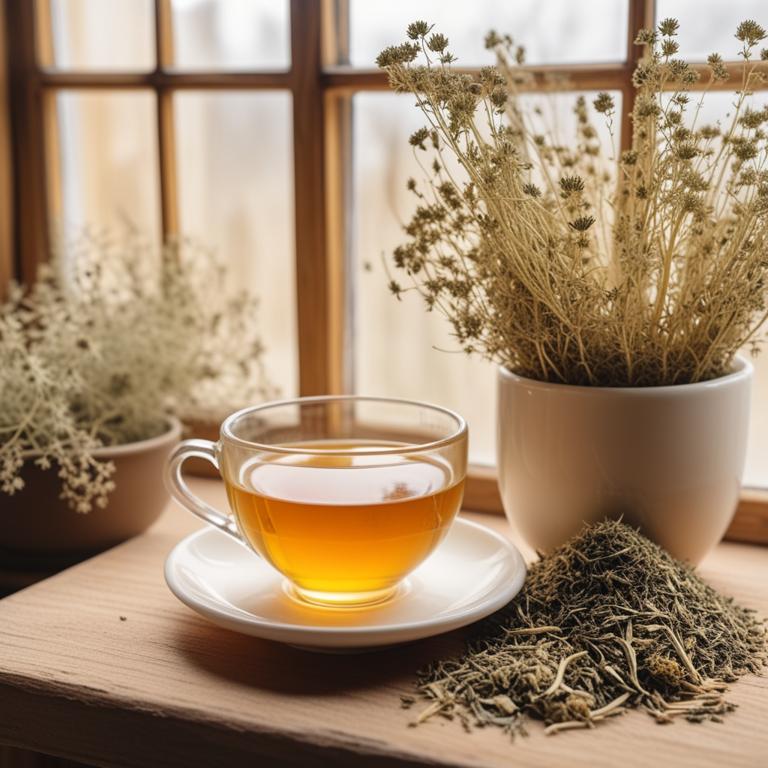
Foeniculum vulgare teas, also known as fennel tea, have been traditionally used to treat gastrointestinal issues such as acid reflux and GERD (Gastroesophageal Reflux Disease).
The anti-inflammatory and antispasmodic properties of this herbal preparation help to soothe the stomach lining and reduce inflammation in the esophagus, thereby alleviating symptoms of GERD.
The bioactive constituents of fennel tea, including anethole, fenchone, and limonene, exhibit carminative and choleretic effects, which aid in reducing stomach acid production and promoting digestive enzyme secretion.
Regular consumption of fennel tea has been found to provide benefits in managing GERD symptoms, such as reduced frequency and severity of acid reflux episodes, improved digestion, and enhanced overall gut health.
Recipe:
- Gather 1 cup of water and 1 teaspoon of dried Foeniculum vulgare seeds. You can also use 2-3 sprigs of fresh Foeniculum vulgare.
- Heat the water in a saucepan over medium heat. Bring the water to a boil, then reduce heat to low.
- Add the Foeniculum vulgare seeds or sprigs to the water. If using seeds, you can crush them lightly before adding.
- Let the mixture steep for 5-7 minutes. You can also let it steep for 10-15 minutes for a stronger tea.
- Strain the tea into a cup and drink. You can add honey or lemon to taste. Drink 1-2 cups of the tea per day for relief from GERD symptoms.
Usage:
- Drink 1 cup of Foeniculum vulgare tea after meals to aid digestion
- Start with 1/4 teaspoon of dried Foeniculum vulgare per cup of tea
- Gradually increase to 1/2 teaspoon per cup if needed for relief
- Drink 2-3 cups of Foeniculum vulgare tea per day for best results
- Consult a doctor for proper dosage and duration of treatment
Foeniculum vulgare teas can be used to treat GERD, but they may cause side effects such as dizziness, headaches, and allergic reactions in some individuals, particularly those who are sensitive to anise or have allergies.
Precautions when using Foeniculum vulgare teas for GERD include avoiding excessive consumption, which may lead to stomach upset and interact with other medications, and being cautious when combining with other herbal remedies that may have similar effects.
4. Cinnamomum verum teas
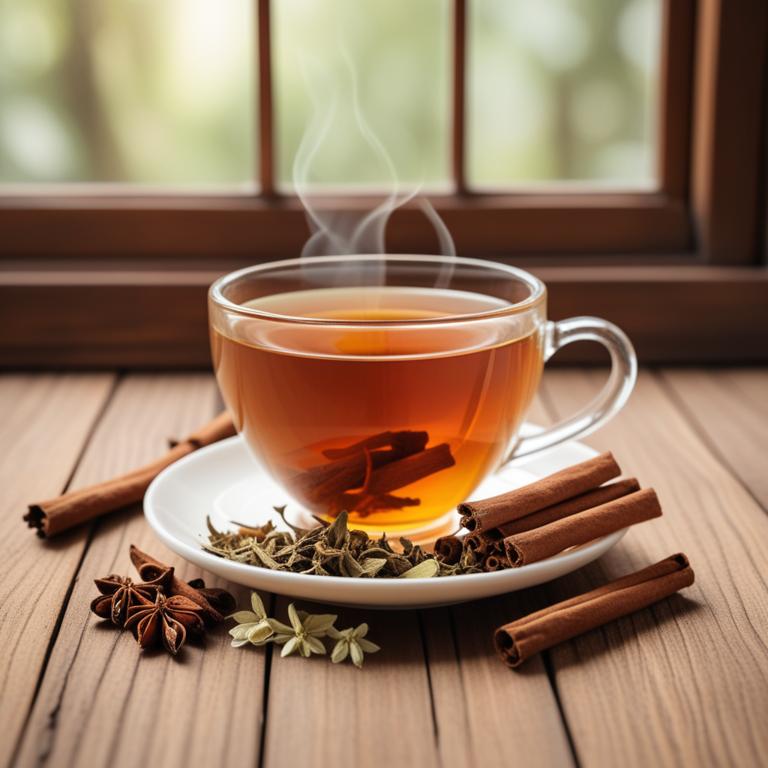
Cinnamomum verum teas have been traditionally used to treat gastroesophageal reflux disease (GERD) due to their anti-inflammatory and carminative properties.
The active compounds present in these teas, such as cinnamaldehyde, linalool, and eugenol, help to reduce inflammation in the esophagus and alleviate symptoms of GERD by relaxing the lower esophageal sphincter and preventing acid reflux.
The bioactive constituents of Cinnamomum verum, including flavonoids and terpenoids, have been shown to exhibit antioxidant and anti-ulcerogenic activities, further contributing to their therapeutic effects in treating GERD.
Overall, the benefits of using Cinnamomum verum teas to treat GERD include reduced symptoms of heartburn and acid reflux, improved digestion, and a lower risk of complications associated with the condition.
Recipe:
- Gather 1 teaspoon of Cinnamomum verum powder, 1 cup of water, and a strainer.
- Boil the water in a kettle or pot.
- Add the Cinnamomum verum powder to the boiling water and stir well.
- Reduce heat and let the mixture simmer for 5-7 minutes.
- Strain the tea into a cup and drink when it's warm. Repeat as needed.
Usage:
- Start with 1 teaspoon of Cinnamomum verum tea powder in 1 cup of boiling water
- Let it steep for 5-7 minutes to release the active compounds
- Strain the tea and drink 1 cup, 2-3 times a day
- Gradually increase to 2 teaspoons per cup for better results
- Continue for 2-4 weeks or as directed by a healthcare professional
Cinnamomum verum teas can provide relief from symptoms of Gerd, but it may also cause side effects such as stomach upset, diarrhea, and allergic reactions in some individuals.
Precautions should be taken when using Cinnamomum verum teas to treat Gerd, including avoiding excessive consumption, as it may irritate the digestive tract and worsen symptoms in people with sensitive stomachs.
5. Mentha x piperita teas
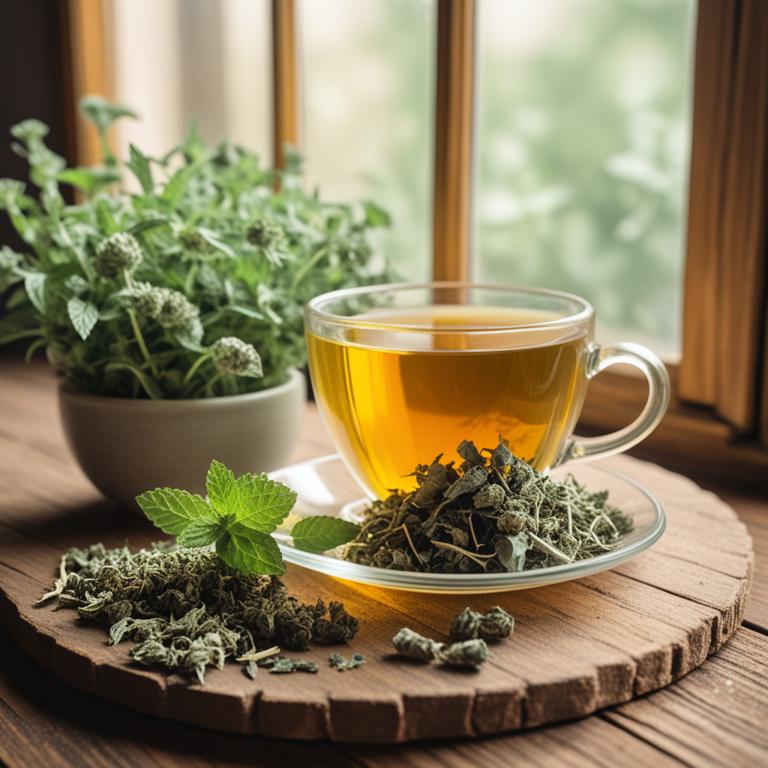
Mentha x piperita teas have been traditionally used to treat gastroesophageal reflux disease (GERD) due to their carminative and anti-inflammatory properties.
The herbal preparation helps to treat GERD by reducing symptoms such as heartburn and regurgitation, alleviating discomfort and promoting a sense of well-being.
The bioactive constituents of Mentha x piperita, including menthol, menthone, and limonene, contribute to its therapeutic effects by relaxing the muscles in the esophagus and reducing inflammation in the esophageal lining.
Regular consumption of Mentha x piperita teas has been shown to provide relief from GERD symptoms and improve overall digestive health.
Related Study
According to the study, Mentha x piperita teas, which is another name for Mentha piperata, are effective in functional dyspepsia.
Recipe:
- Boil 1 cup of water in a pot.
- Add 5-7 fresh Mentha x piperita leaves or 1 teaspoon of dried leaves to a teapot.
- Pour the boiled water over the leaves and let it steep for 5-7 minutes.
- Strain the tea into a cup and add 1 tablespoon of honey if desired.
- Drink the tea slowly and wait for 30 minutes to see the effect on your Gerd symptoms.
Usage:
- Drink 1-2 cups of Mentha x piperita tea after meals.
- Take 1 teaspoon of dried Mentha x piperita leaves per cup.
- Use tea 2-3 times a day for 1-2 weeks to alleviate symptoms.
- Increase dosage to 1-2 cups 3 times a day for severe Gerd.
- Monitor your symptoms and adjust dosage as needed with a doctor.
Mentha x piperita teas can provide relief from GERD symptoms, but it may cause side effects such as stomach upset, diarrhea, and allergic reactions in some individuals.
To use Mentha x piperita teas safely, take precautions to avoid consuming it in excessive amounts, as this can lead to liver damage, and also be cautious of interactions with other medications, such as blood thinners, and monitor blood sugar levels if you have diabetes.
6. Cinchona officinalis teas
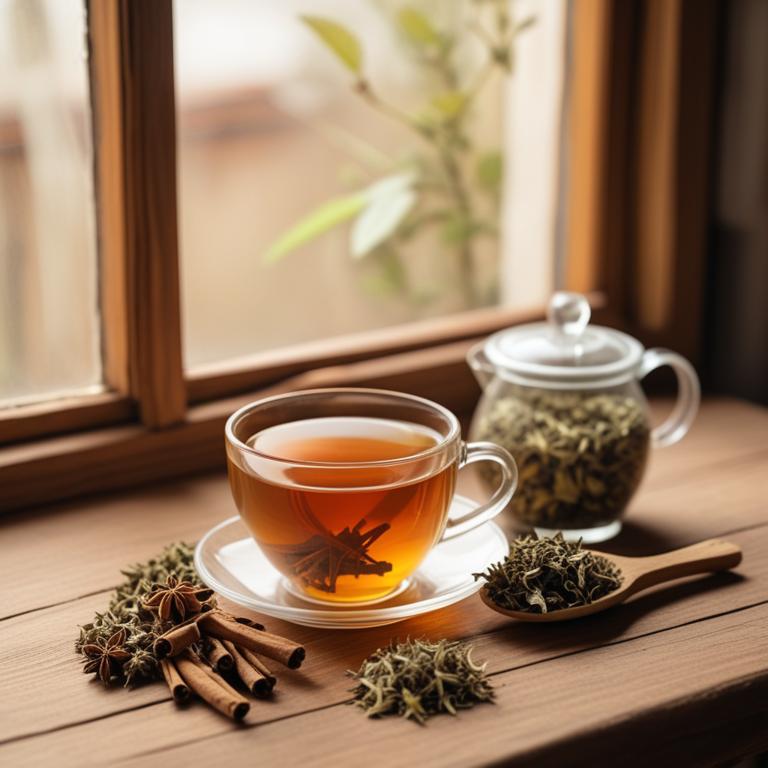
Cinchona officinalis teas, also known as Peruvian bark, have been traditionally used to treat gastrointestinal issues, including gastroesophageal reflux disease (GERD).
The anti-inflammatory and antispasmodic properties of Cinchona officinalis help to soothe and calm the digestive tract, reducing inflammation and alleviating symptoms of GERD such as heartburn and acid reflux.
The bioactive constituents of Cinchona officinalis, including alkaloids like quinine and cinchonine, contribute to its therapeutic effects by relaxing the smooth muscles in the digestive tract and reducing inflammation.
The benefits of Cinchona officinalis teas in treating GERD include improved digestion, reduced symptoms of heartburn and acid reflux, and a decrease in inflammation and irritation in the esophagus.
Recipe:
- Gather 1 cup of fresh Cinchona officinalis leaves or 2 teaspoons of dried leaves.
- Boil 1 cup of water in a pot.
- Add the Cinchona leaves to the boiling water.
- Reduce heat and let it simmer for 5-7 minutes.
- Strain and drink the tea, 2-3 times a day for relief from Gerd symptoms.
Usage:
- Consult a doctor before using Cinchona officinalis for GERD treatment.
- Use 1/2 teaspoon of dried Cinchona officinalis in 1 cup of hot water.
- Drink 1 cup of Cinchona officinalis tea 2-3 times a day after meals.
- Take 300-400 mg of Cinchona officinalis extract per day in divided doses.
- Continue treatment for 4-6 weeks and monitor symptoms for improvement.
Cinchona officinalis teas can be used to treat the gerd ailment, but possible side effects may include gastrointestinal upset, dizziness, and allergic reactions due to the high quinine content, which may interact with certain medications.
Precautions should be taken when using this herbal preparation, such as avoiding use in pregnant or breastfeeding women, individuals with kidney or liver disease, and those sensitive to quinine, and also being mindful of the recommended dosage to minimize the risk of side effects.
7. Piper nigrum teas
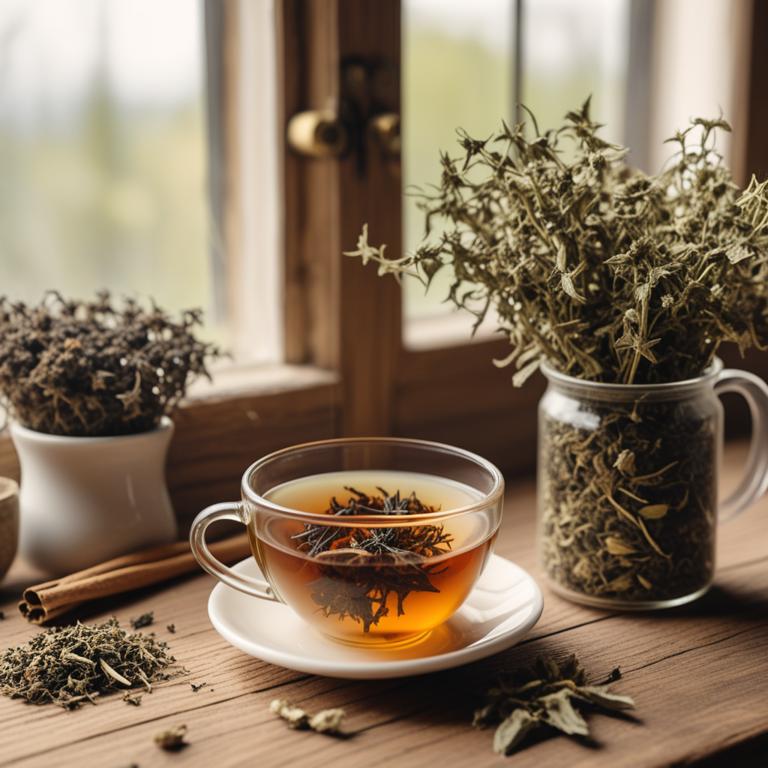
Piper nigrum teas, derived from black pepper, have been traditionally used to treat Gastroesophageal Reflux Disease (GERD) due to their carminative and anti-inflammatory properties.
The bioactive constituents of Piper nigrum, including piperine, piperonal, and limonene, help to reduce inflammation in the esophagus and alleviate symptoms of GERD by improving digestion and reducing the frequency of acid reflux episodes.
The herbal preparation helps to treat GERD by promoting the relaxation of the lower esophageal sphincter, preventing stomach acid from flowing back into the esophagus and reducing symptoms of heartburn and regurgitation.
Regular consumption of Piper nigrum teas has been shown to provide relief from GERD symptoms and improve overall gut health, making it a beneficial natural remedy for individuals suffering from this condition.
Recipe:
- Boil 1 cup of water in a teapot.
- Add 1/2 teaspoon of whole black pepper (Piper nigrum) to the boiling water.
- Reduce heat and let it simmer for 5-7 minutes.
- Strain the tea into a cup and discard the pepper.
- Drink the tea 30 minutes before meals to help alleviate Gerd symptoms.
Usage:
- Drink 1 cup of Piper nigrum tea after meals to calm the stomach.
- Consume 1/2 teaspoon of Piper nigrum powder per cup of tea.
- Use Piper nigrum tea 2-3 times a day, as needed.
- Start with a small dose and adjust as needed for better results.
- Continue using Piper nigrum tea for 2-4 weeks to see noticeable relief.
Piper nigrum teas can be used to treat Gerd, but possible side effects may include stomach upset, nausea, and heartburn due to the high concentration of piperine, a compound that can exacerbate the symptoms in some individuals.
Precautions when using Piper nigrum teas to treat Gerd include avoiding overconsumption, as this may lead to increased stomach acid production and further discomfort, and also being mindful of individual tolerance to ensure a safe and effective treatment.
8. Zanthoxylum bungeanum teas
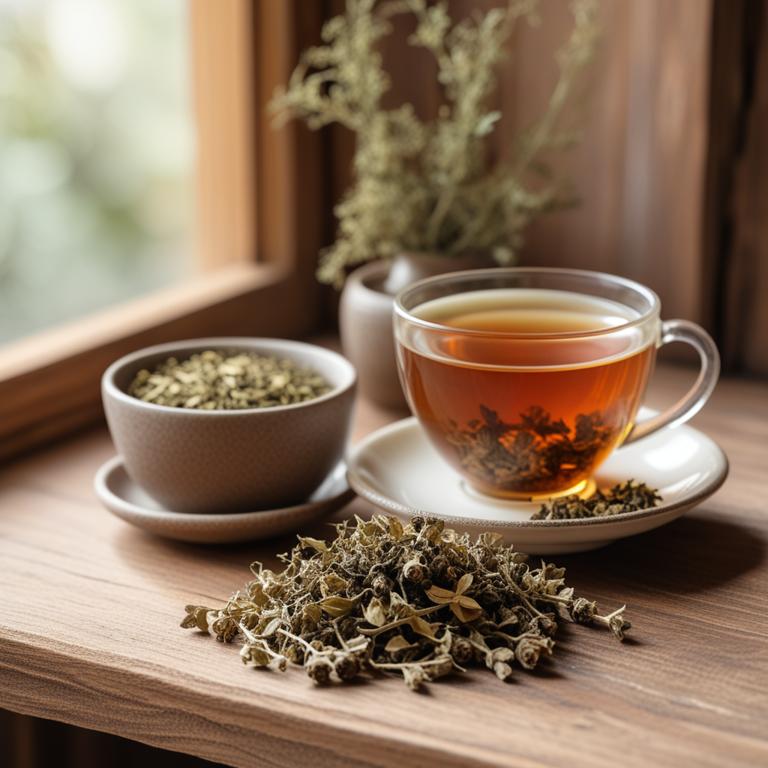
Zanthoxylum bungeanum teas have been traditionally used to treat gastrointestinal issues, including gastroesophageal reflux disease (GERD).
The anti-inflammatory and antioxidant properties of this herbal preparation help to soothe the digestive system, reducing inflammation and alleviating symptoms of GERD.
The bioactive constituents of Zanthoxylum bungeanum teas, including flavonoids and alkaloids, have been shown to exhibit gastroprotective effects, helping to reduce acid secretion and heal gastric ulcers.
Regular consumption of Zanthoxylum bungeanum teas may provide benefits in managing GERD symptoms, such as reducing heartburn and acid reflux, and promoting a healthy digestive system.
Recipe:
- Gather 1 tablespoon of dried Zanthoxylum bungeanum leaves and 1 cup of water.
- Heat the water in a pot until it boils.
- Add the dried leaves to the boiling water and remove from heat.
- Steep the mixture for 5-7 minutes, then strain the leaves.
- Drink 1/2 cup of the tea, 2-3 times a day, to help with acid reflux symptoms.
Usage:
- Drink 1/4 cup of Zanthoxylum bungeanum tea 2 times a day.
- Use 5-7 grams of dried Zanthoxylum bungeanum leaves per cup.
- Start with low dose (1/4 cup) and adjust as needed.
- Continue for 2-3 weeks and reassess symptoms.
- Consult doctor if symptoms persist or worsen after 3 weeks.
Zanthoxylum bungeanum teas can be used to treat GERD, but possible side effects may include dizziness, nausea, and stomach upset due to its high tannin and volatile oil content.
To minimize potential side effects, it is recommended to start with small doses and gradually increase as needed, also avoiding consumption before bedtime and in large amounts, especially when taken with other medications or certain foods.
9. Ginkgo biloba teas
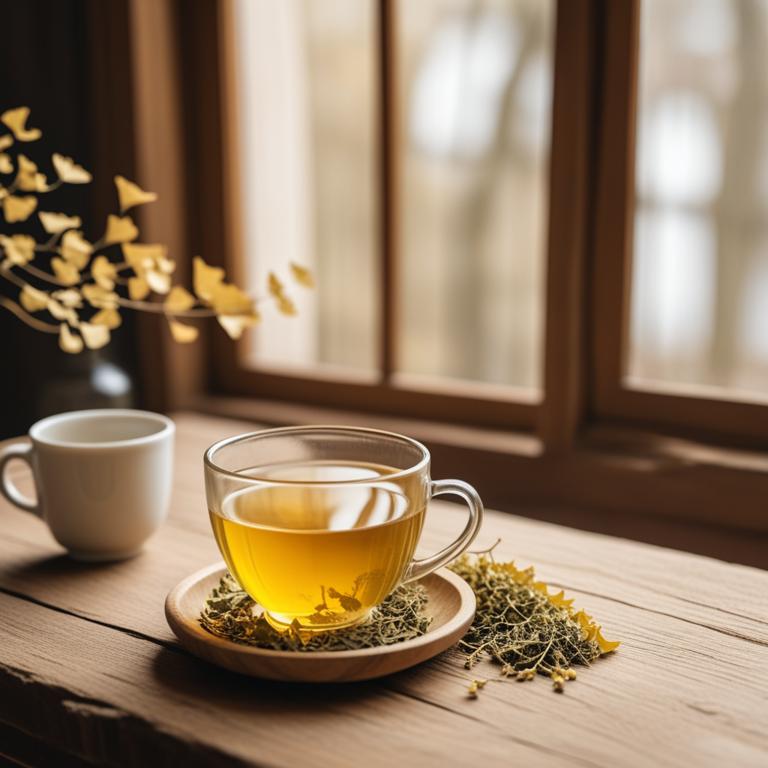
Ginkgo biloba teas have been traditionally used to help alleviate symptoms of Gastroesophageal Reflux Disease (GERD), a condition characterized by the backflow of stomach acid into the esophagus.
The herbal preparation's properties, including its anti-inflammatory and antioxidant effects, help to reduce inflammation in the esophagus and alleviate symptoms of GERD.
The bioactive constituents of Ginkgo biloba, such as flavonoids and terpenoids, have been found to relax the lower esophageal sphincter, allowing food to pass more easily into the stomach and reducing the likelihood of acid reflux.
By using Ginkgo biloba teas, individuals with GERD can experience relief from symptoms, including heartburn, regurgitation, and difficulty swallowing, making it a potentially beneficial herbal remedy for managing this common digestive disorder.
Recipe:
- Gather 1 tablespoon of dried Ginkgo biloba leaves and 1 cup of boiling water.
- Let the Ginkgo biloba leaves steep in the boiling water for 5-7 minutes.
- Strain the mixture into a cup to remove the leaves.
- Add honey to taste, if desired, and stir well.
- Drink the tea 1-2 times a day to help with Gerd symptoms.
Usage:
- Drink 1-2 cups of Ginkgo biloba tea after meals to ease digestion.
- Take 1 teaspoon of Ginkgo biloba powder or 2 tea bags per cup.
- Start with 1 cup per day and increase to 2 cups as needed.
- Consume Ginkgo biloba tea 30 minutes to 1 hour before meals.
- Continue using Ginkgo biloba tea for 2-3 weeks to see results.
Ginkgo biloba teas can be considered as an alternative treatment for GERD, but they may cause side effects such as stomach upset, diarrhea, and allergic reactions in some individuals.
To use Ginkgo biloba teas for treating GERD, it is recommended to take them in moderation and with food to minimize stomach irritation, as high doses or prolonged use may exacerbate the symptoms.
Ginkgo Biloba Tea on Amazon
Tai Chi Think Sharp Energizing Tea (Ginseng Ginkgo Biloba) 12 Bags
Disclaimer: We earn a commission if you click this link and make a purchase at no additional cost to you.
10. Curcuma longa teas
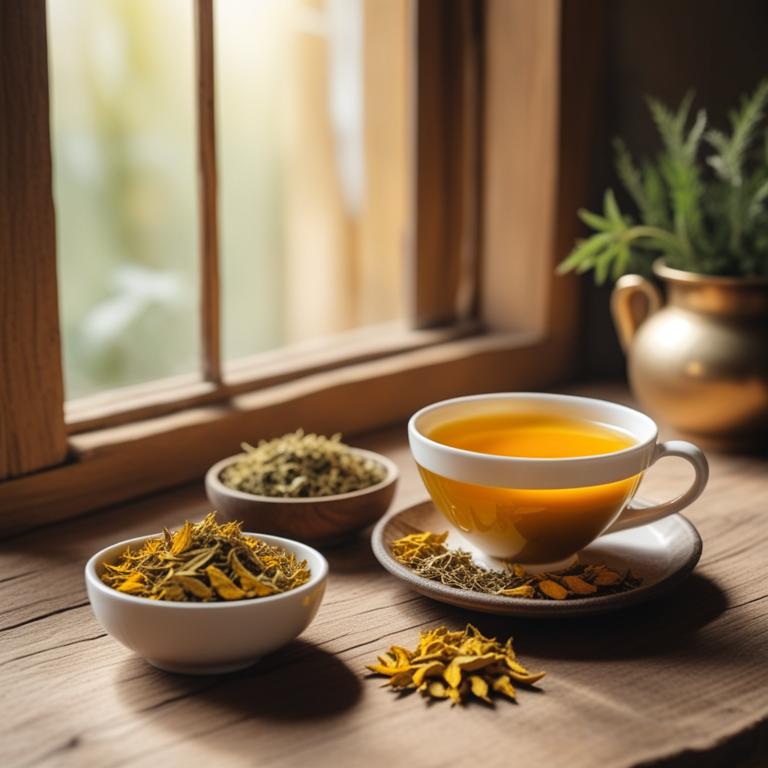
Curcuma longa teas, derived from the root of the turmeric plant, have been traditionally used to treat gastroesophageal reflux disease (GERD) due to their anti-inflammatory and carminative properties.
The bioactive constituents present in Curcuma longa teas, including curcuminoids and polyphenols, help to reduce inflammation and alleviate symptoms associated with GERD.
These constituents work by enhancing the barrier function of the lower esophageal sphincter, reducing gastric acid secretion, and modulating gut motility.
The benefits of using Curcuma longa teas to treat GERD include improved digestion, reduced symptoms of heartburn and acid reflux, and enhanced overall gastrointestinal health.
Related Study
According to the study, Curcuma longa teas for GERD may be beneficial due to the presence of curcumin, a compound with potential to alleviate pain and discomfort in patients with gastrointestinal conditions.
Recipe:
- Boil 1 cup of water in a kettle or pot.
- Measure 1 teaspoon of dried Curcuma longa root and place it in a tea infuser or a small muslin cloth.
- Pour the boiling water over the Curcuma longa root in the infuser or cloth.
- Let the tea steep for 5-7 minutes, then remove the infuser or cloth.
- Strain the tea and drink it warm, adding 1 tablespoon of honey if needed.
Usage:
- Start with 1 teaspoon of Curcuma longa powder in 1 cup of warm water.
- Drink tea 2-3 times a day, before meals.
- Begin with 500 mg of Curcuma longa per serving, adjust as needed.
- Drink tea for 2-4 weeks to see noticeable effects on GERD.
- Consult doctor before changing or stopping Curcuma longa tea use.
Curcuma longa teas can be beneficial in treating Gerd ailments; however, using them may lead to side effects such as nausea, diarrhea, and stomach cramps, especially when consumed in large quantities or for extended periods.
To safely use Curcuma longa teas for Gerd treatment, take precautions by starting with small doses, avoiding mixing it with other medications, and being cautious with individuals with sensitive stomachs or allergies.
Curcuma Longa Tea on Amazon
Pure Ceylon Turmeric Brew - 100% Organic Ceylon Turmeric Tea Bags (40 Sachets - pack of 2 – 20 COUNT PER BOX)
Disclaimer: We earn a commission if you click this link and make a purchase at no additional cost to you.
11. Coriandrum sativum teas
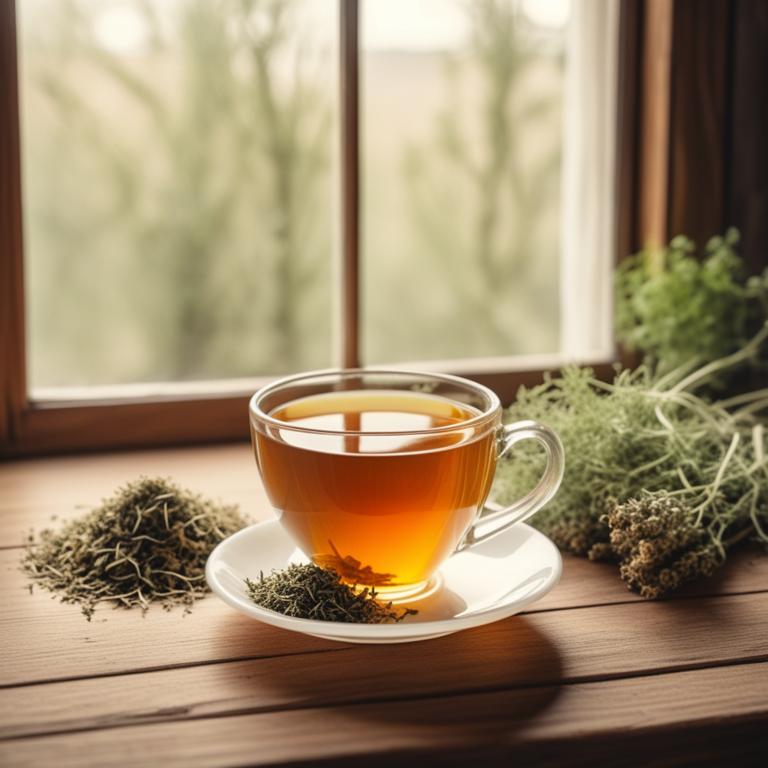
Coriandrum sativum teas, also known as coriander tea, have been traditionally used to treat gastroesophageal reflux disease (GERD) due to their anti-inflammatory and carminative properties.
The herbal preparation helps to treat GERD by reducing inflammation in the esophagus and alleviating symptoms such as heartburn and acid reflux, thereby providing relief to patients suffering from this ailment.
The bioactive constituents of coriandrum sativum teas, including linalool, linalyl acetate, and geranyl acetate, contribute to their therapeutic effects by inhibiting the production of stomach acid and improving digestion.
The benefits of using coriandrum sativum teas to treat GERD include reduced symptoms, improved quality of life, and a natural alternative to pharmaceutical medications.
Recipe:
- Gather 1 cup of fresh Coriandrum sativum leaves or 2 tablespoons of dried leaves.
- Bring 1 cup of water to a boil in a saucepan.
- Add the Coriandrum sativum leaves to the boiling water.
- Reduce heat and let it steep for 5-7 minutes.
- Strain the tea and drink 1/2 cup, 2-3 times a day to help manage GERD symptoms.
Usage:
- Start with 1 cup of Coriandrum sativum tea, 2-3 times a day.
- Drink tea 30 minutes before meals to reduce acid production.
- Use 1 tablespoon of Coriandrum sativum extract for 3 times a day.
- Gradually increase tea consumption to 2-3 cups a day, as needed.
- Monitor symptoms and adjust tea consumption for optimal relief.
Coriandrum sativum teas can be used to potentially alleviate symptoms of gastroesophageal reflux disease (GERD), but it may cause side effects such as dizziness, stomach cramps, and allergic reactions in some individuals.
Precautions should be taken when using Coriandrum sativum teas to treat GERD, including not consuming large amounts, avoiding mixing with other medications or herbal preparations, and being cautious when driving or operating heavy machinery.